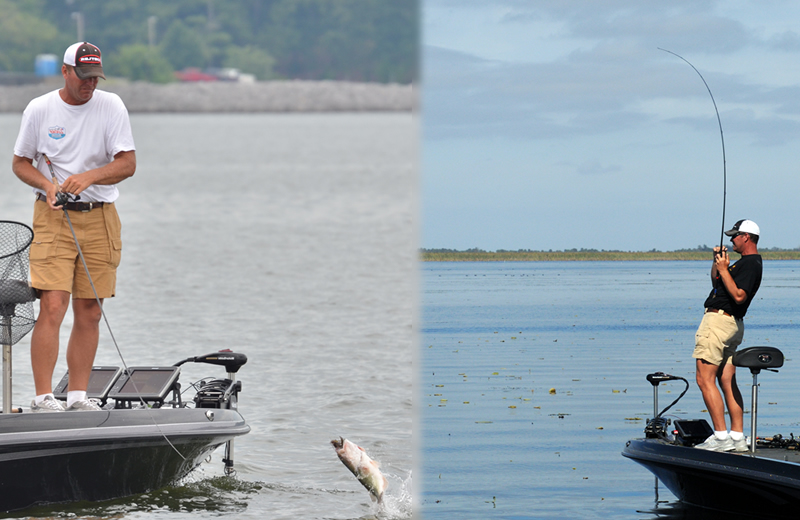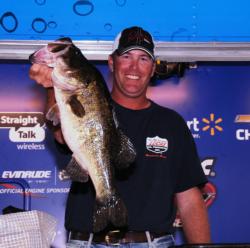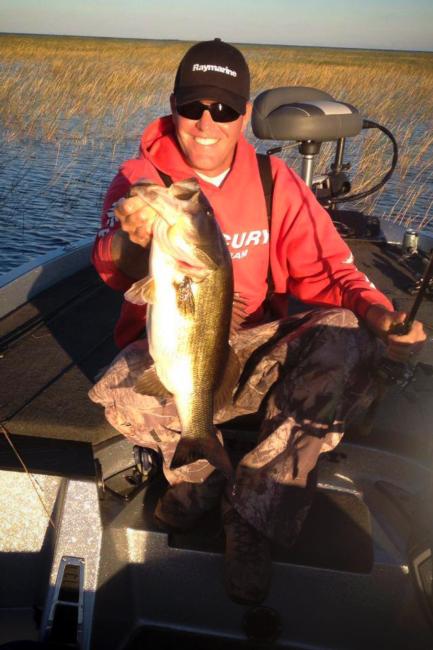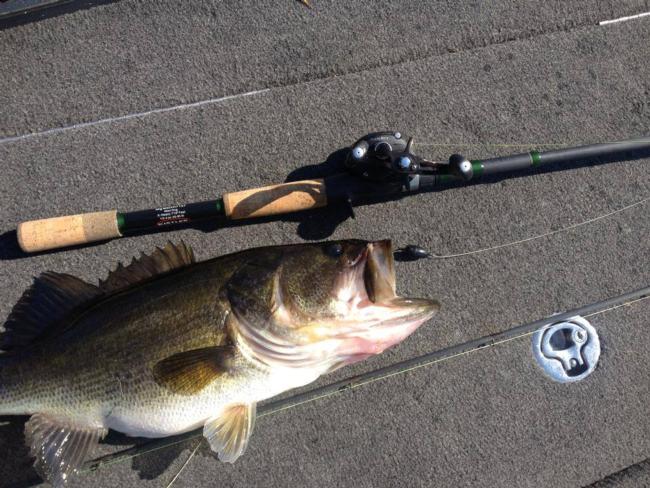From Ledges to Lily Pads
Haynes' quest to better understand Florida fishing

Ask anyone who fishes the FLW Tour who the best offshore ledge fisherman is on the Tour and many pros will say the name Randy Haynes without a hesitation.
Indeed, in a matter of five years Haynes has gone from a local “ledgemaster” on Pickwick Lake to an FLW Tour “ledge-end” for his detailed understanding of how fish position on offshore drops along the Tennessee River. Haynes was one of the first to scour the river ledges of Pickwick Lake with down- and side-scan technology. He more or less pioneered the use of double “big screen” electronics in the console and bow.
His resume includes five Rayovac FLW Series wins, one FLW Tour win and just over $500,000 in winnings, mostly derived from bass that live on offshore structure.
Undoubtedly, when it comes to fishing offshore schools, Randy Haynes is in a league of his own.
But for the last five weeks, Haynes has been in a different league – a league that’s located about 800 miles south of his TVA wheelhouse – a league that involves lanes and lily pads instead of ledges and locks.
On December 10th, 2014 Haynes packed his family up, hooked up the boat and lit out for a much warmer Clewiston, Fla., where he has spent the winter deeply engrained in a study of shallow water bass on Lake Okeechobee.
Though Florida is blessed with some of the best bass fisheries on earth, those natural lakes have often been a thorn in the side of touring pros that are unfamiliar with the shallow, vegetation-filled waters and fickle Florida strain bass. For a guy like Haynes, who essentially makes his living off of depth contours, Okeechobee can be a flat deal breaker, so to speak.
Haynes got his initial dose of Florida in 2011 when he finished 80th place in his first Rayovac on Okeechobee. In 2013 he finished 160th. Last year he spent a little more time in Florida and the result was a third place showing in the Rayovac. But then the Big O retaliated in the FLW Tour event, sticking him with a 104th place finish, which set a fire under Haynes and led to his early pilgrimage to the Sunshine State in December.
Though he has not officially earned “snowbird” status yet, his dedication to Okeechobee has taught him quite a bit about Florida fishing, which he hopes will pay off soon.
Category killers
From a financial perspective, Haynes has broken successful tournament anglers down into two types: The jacks of all trades: anglers who earn consistent checks all year and category killers: those who dominate a specific type of fishing, walking away with all marbles when an event is held in their wheelhouse.
Haynes is certainly in the latter group, as his domination in offshore fishing has earned him multiple wins, and in his mind, Florida offers that same kind of category-killing potential.
“What intrigues me the most about Florida are the few guys that seem to dominate there year after year,” Haynes says, citing Okeechobee aces Randall Tharp and Brandon McMillan as examples. “If those guys are in a tournament on Okeechobee, there is a good chance they will both be in the top five and one will win.”
“They understand certain things about that type of fishing that puts them worlds ahead of everyone else,” Haynes continues. “They have a supreme confidence in that way of fishing that makes them dominant. Whenever there is a certain type of fishing that has the potential for the same guys to dominate time and time again, that really intrigues me because that’s the way you make money in this sport.”
Looked at another way, the potential to win on upland impoundments with mixed species – perhaps like Beaver Lake, Table Rock or Lanier – is much more spread out. It’s more prone to be anyone’s ball game. But Florida is more specialized.
“There are only a few places in this sport to sort of corner the market like that,” Haynes opines. “TVA ledge fishing is one, Florida fishing is one and I also think herring-based fishing that guys like Casey Ashley and Anthony Gagliardi understand so well is another.”
While Haynes says he is no threat to corner the Florida market as of yet, he is learning about the details that drive the domination.
Just as Haynes is finely attuned to all the subtleties of TVA ledge fishing, he sees the same types of critical nuances in Florida. One thing is for sure, he appreciates the art of refining the subtleties to be a category killer.
“Specialists know how to generate more bites per day in their type of fishing; they understand the little things so well,” Haynes says. “I’ve been in the boat with Brandon several times and he always gets more bites than I do.
“Just like I know exactly what a plug is supposed to feel like on a good mussel bar on Pickwick in just the right amount of current, he knows exactly what a good mat feels like, how thick it should be, the right water color, how to let the bait fall – all that stuff comes into to play in getting more bites in the course of the day.”
Haynes says the same holds true for Brandon’s brother, Jared McMillan, who is a “winding specialist” when it comes to buzzing soft-plastics over the hay grass.
“Just knowing things like when to throw a swim jig versus a Big EZ, when to fish the thicker hay versus the thinner hay, when to speed it up or kill it if a fish wakes it, when to set the hook immediately or give the fish a split-second more to get it,” Haynes continues. “Jared knows those things and that’s why he puts 20 pounds in the boat doing it when others only catch 12.”
Given Haynes casting and winding background on ledge fisheries, one would assume the casting and winding game would be his preference on Okeechobee. But he is more taken with the mat-punching method.
“The landing percentage for me is far better in using the short string in those mats,” Haynes says. “I lose too many big ones winding over that hay; it’s some tough stuff and it gets the better of me. Guys that can always put the big bites in the boat in that hay are impressive. But, that’s my point: a specialist is going to outperform others on a particular style of fishing like that.”
One step ahead
Though Lake Okeechobee and Pickwick are universes apart in terms of their dynamics, Haynes sees a striking similarity in the two fisheries that really fires him up.
“The way those big schools at Pickwick will show up on a ledge that was barren the day before is the same exact way those big waves move in at Lake Okeechobee and just cover up a place that didn’t have a fish on it the day before,” Haynes points out. “That gets me going because that’s the key to winning tournaments on both lakes. In that respect, they are identical.”
The similarities don’t end there, either. On Pickwick or Kentucky Lake, when one or two boats start catching fish on a particular ledge, there will be 10 boats there the next day and 20 the next. Haynes has witnessed the same phenomenon on Okeechobee.
“Once word gets out, boats will cover a place up and then it’s too late,” he said. “The trick is to be that first boat there when a pile of fresh fish is moving in.”
The key to being a step ahead of the competition is to actually be a step ahead of the fish and Haynes understands this concept all to well. On Pickwick it takes several bites to get a feel for what the fish are doing and where they are headed. In Florida, a single bite can carry that same critical information.
“Those Florida boys can get a bite, look around and know where the next bite going to happen,” Haynes laughs. “I get a bite, look around and I’m just as confused as I was before I got the bite.
“But that’s the difference – knowing where those fish are going – not where they were or even where they are now – but where they are going.”
Coming full circle
After several trips to Okeechobee over the years, Haynes is still amazed at how drastically it changes year to year. Where reeds and the “hardline” were one year is open lake the next year and then matted hydrilla the next.
“It’s just crazy,” Haynes says. “Water level and wind really shape this place year to year. It’s not a waypoint lake in the sense that you can mark a piece of structure that never moves. This whole lake is moving all the time and I really like that.”
In fact, the part of Okeechobee that Haynes has enjoyed the most is actually fishing to find fish instead of riding around with a down-scan looking for schools and marking them on a GPS.
 “The electronics are so good these days that the only way we find fish back home anymore is to idle around 12 hours a day looking for them,” Haynes says. “This is the way it used to be on Pickwick before the good electronics. You had to actually fish to find fish. Down here, the only way you can discover those little changes in watercolor, vegetation thickness and bottom is to just put the trolling motor down and fish for miles – and I love that.”
“The electronics are so good these days that the only way we find fish back home anymore is to idle around 12 hours a day looking for them,” Haynes says. “This is the way it used to be on Pickwick before the good electronics. You had to actually fish to find fish. Down here, the only way you can discover those little changes in watercolor, vegetation thickness and bottom is to just put the trolling motor down and fish for miles – and I love that.”
It’s almost a contradictory statement coming from a man who, in many ways, turned the fishing world onto the magic of a down-scan beam.
“The only magical way to find fish down here is to use those dern golden shiners,” Haynes adds with a laugh. “Lord have mercy, I’ve watched those shiner guys catch those big ones one right after the other and I can’t get a sniff on an artificial – it beats all I have ever seen.”
